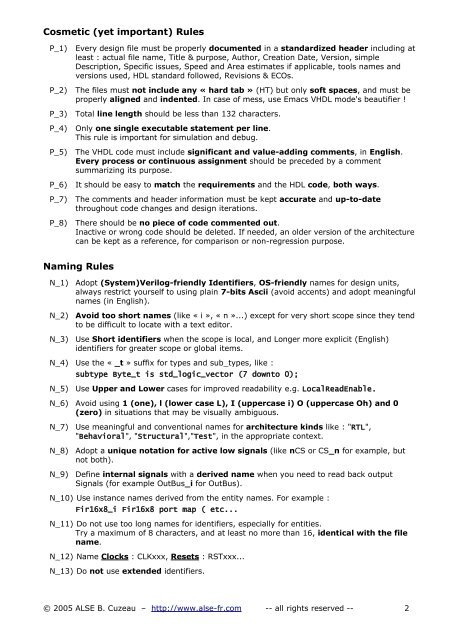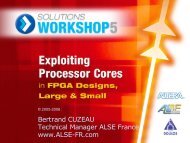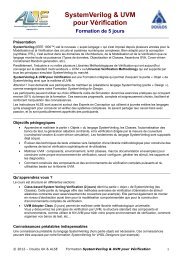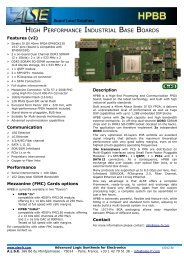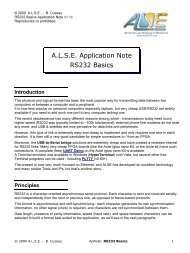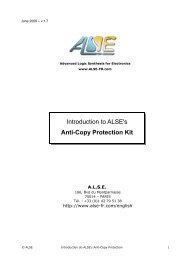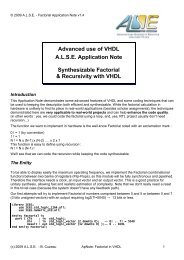Design & Coding Style Guide - ALSE
Design & Coding Style Guide - ALSE
Design & Coding Style Guide - ALSE
Create successful ePaper yourself
Turn your PDF publications into a flip-book with our unique Google optimized e-Paper software.
Cosmetic (yet important) Rules<br />
P_1)<br />
P_2)<br />
P_3)<br />
P_4)<br />
P_5)<br />
P_6)<br />
P_7)<br />
P_8)<br />
Every design file must be properly documented in a standardized header including at<br />
least : actual file name, Title & purpose, Author, Creation Date, Version, simple<br />
Description, Specific issues, Speed and Area estimates if applicable, tools names and<br />
versions used, HDL standard followed, Revisions & ECOs.<br />
The files must not include any « hard tab » (HT) but only soft spaces, and must be<br />
properly aligned and indented. In case of mess, use Emacs VHDL mode's beautifier !<br />
Total line length should be less than 132 characters.<br />
Only one single executable statement per line.<br />
This rule is important for simulation and debug.<br />
The VHDL code must include significant and value-adding comments, in English.<br />
Every process or continuous assignment should be preceded by a comment<br />
summarizing its purpose.<br />
It should be easy to match the requirements and the HDL code, both ways.<br />
The comments and header information must be kept accurate and up-to-date<br />
throughout code changes and design iterations.<br />
There should be no piece of code commented out.<br />
Inactive or wrong code should be deleted. If needed, an older version of the architecture<br />
can be kept as a reference, for comparison or non-regression purpose.<br />
Naming Rules<br />
N_1)<br />
N_2)<br />
N_3)<br />
Adopt (System)Verilog-friendly Identifiers, OS-friendly names for design units,<br />
always restrict yourself to using plain 7-bits Ascii (avoid accents) and adopt meaningful<br />
names (in English).<br />
Avoid too short names (like « i », « n »...) except for very short scope since they tend<br />
to be difficult to locate with a text editor.<br />
Use Short identifiers when the scope is local, and Longer more explicit (English)<br />
identifiers for greater scope or global items.<br />
N_4) Use the « _t » suffix for types and sub_types, like :<br />
subtype Byte_t is std_logic_vector (7 downto 0);<br />
N_5)<br />
Use Upper and Lower cases for improved readability e.g. LocalReadEnable.<br />
N_6) Avoid using 1 (one), l (lower case L), I (uppercase i) O (uppercase Oh) and 0<br />
(zero) in situations that may be visually ambiguous.<br />
N_7)<br />
N_8)<br />
N_9)<br />
Use meaningful and conventional names for architecture kinds like : "RTL",<br />
"Behavioral", "Structural","Test", in the appropriate context.<br />
Adopt a unique notation for active low signals (like nCS or CS_n for example, but<br />
not both).<br />
Define internal signals with a derived name when you need to read back output<br />
Signals (for example OutBus_i for OutBus).<br />
N_10) Use instance names derived from the entity names. For example :<br />
Fir16x8_i Fir16x8 port map ( etc...<br />
N_11) Do not use too long names for identifiers, especially for entities.<br />
Try a maximum of 8 characters, and at least no more than 16, identical with the file<br />
name.<br />
N_12) Name Clocks : CLKxxx, Resets : RSTxxx...<br />
N_13) Do not use extended identifiers.<br />
© 2005 <strong>ALSE</strong> B. Cuzeau – http://www.alse-fr.com -- all rights reserved -- 2


